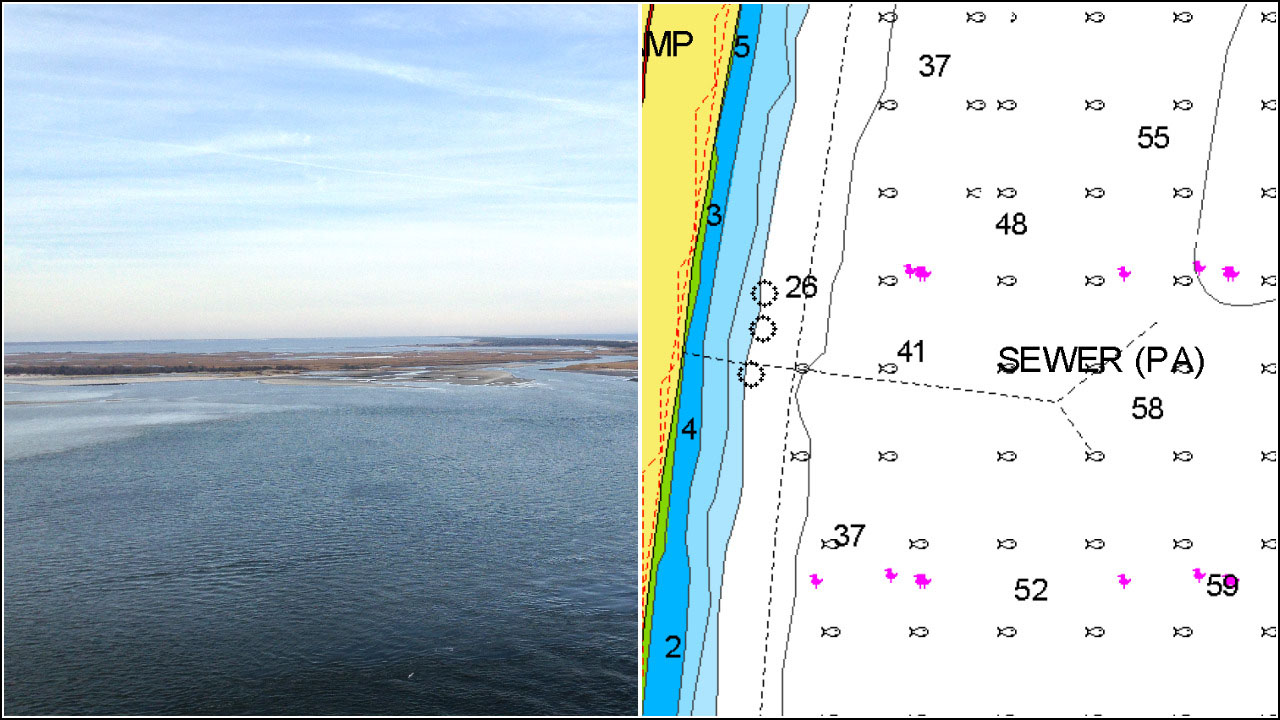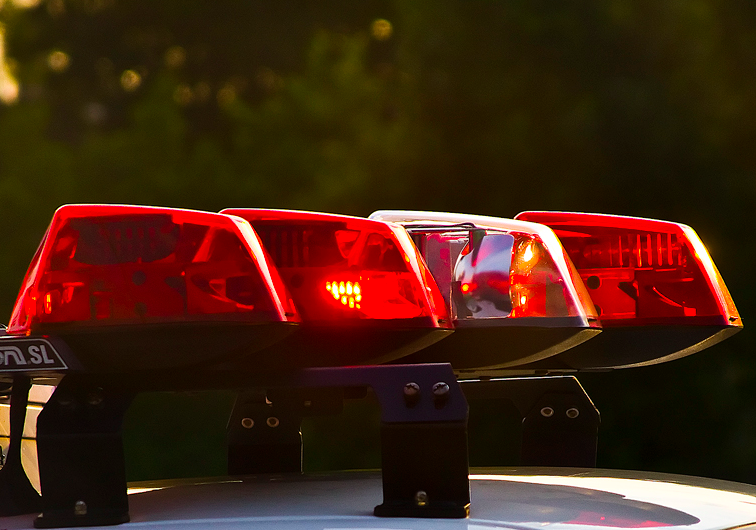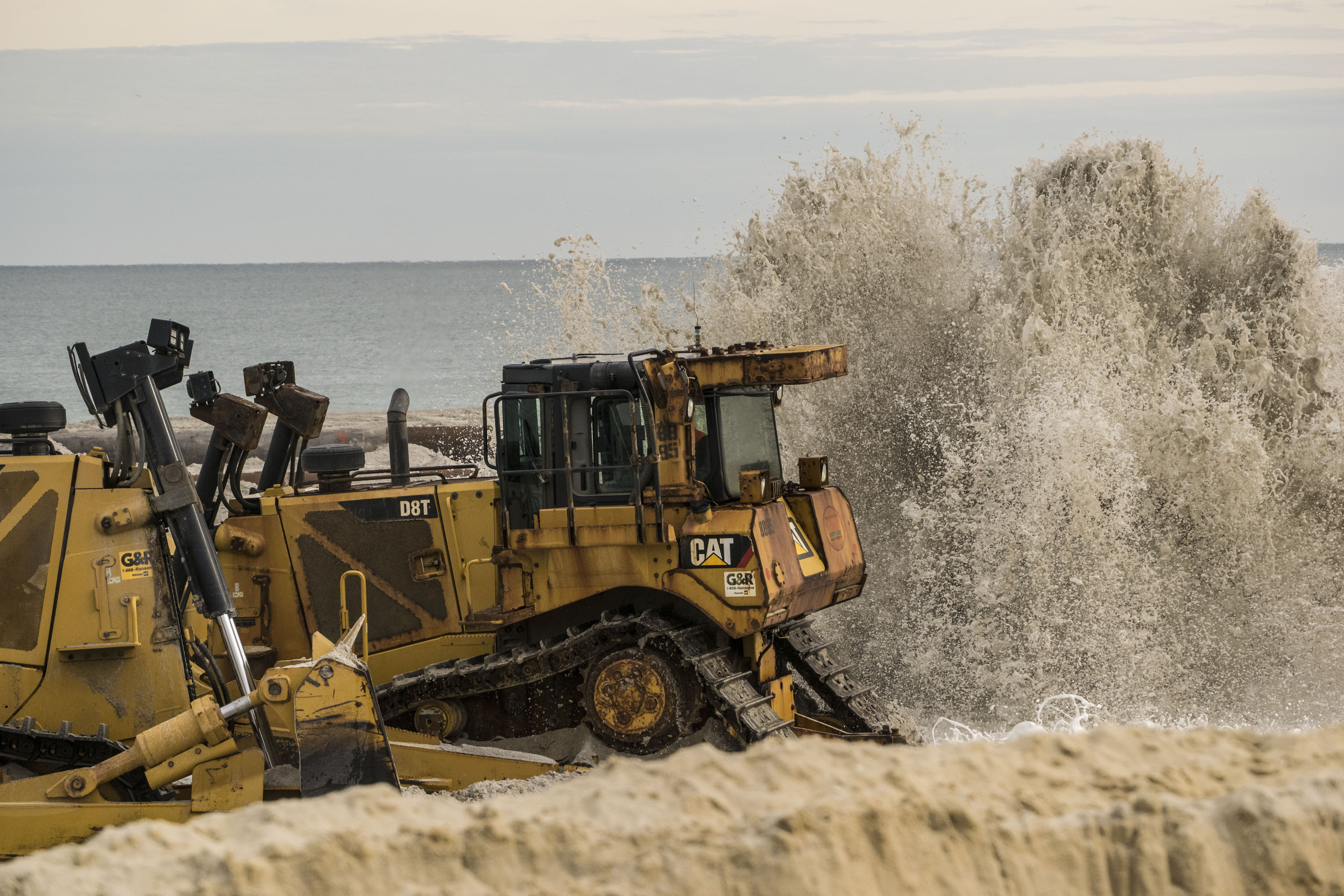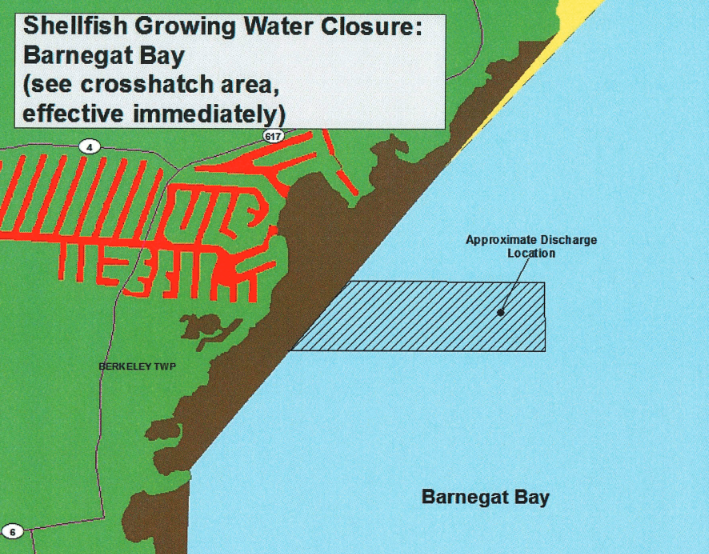
A pipeline between Bayville and the Atlantic Ocean is leaking in Barnegat Bay. (Photo: Daniel Nee/Nautical Chart)
A 54-inch outfall pipe that runs from an Ocean County Utilities Authority sewage treatment facility in Berkeley Township to the Atlantic Ocean is leaking in Barnegat Bay, and officials say repairs will take until the end of the month.
Shorebeat has confirmed that a leak in the pipe, which runs from Allen Road in Bayville, under the bay and discharges in the ocean 5,000 feet off South Seaside Park, has been leaking since at least Oct. 9, when crews injected a dye into the pipe to test its integrity. The dye tests are conducted every five years and it is unknown how long the leak had been occurring, said Keith Marcoon, executive director of OCUA.
“We expect to have this leak completely repaired by the end of November,” said Marcoon.
The dye test is performed by injecting a “food-grade” dye, Marcoon said, into the pipeline, which is submerged several feet under water. A county helicopter hovers overhead in order to see whether any of the dye reaches the surface of the bay. The Oct. 9 test detected a leak about 1,400 feet east of the Allen Road pumping station, necessitating a second test Oct. 17 with divers present to investigate the source of the leak in person.
“We immediately reported the suspected leak to New Jersey DEP and we continue to keep them updated of our findings and repair processes,” Marcoon said.
The handling of the leak has caused concern on the part of some people within county government, sources said. Though the state was notified, OCUA did not make any public statements on the issue. The DEP itself issued one legally-mandated announcement that shellfish beds in an area of the bay were being closed Oct. 12 due to a leaking pipe, but did not provide any detail. A DEP spokesperson was unaware of the issue and said a comment would be forthcoming later this week.
Marcoon said his agency does not normally issue press releases, and instead focused on taking the steps to repair the pipe.
“We engaged with a contractor within 48 hours,” he said, and “immediately reported the suspected leak to New Jersey DEP.”
Within a few days, repairs began, said Marcoon. OCUA has hired Caldwell Marine International, of Farmingdale, to repair the pipeline.
Additionally, the agency did conduct some public outreach. Marcoon said the agency contacted Dr. Stan Hales, Director of the Barnegat Bay Partnership, who shared information on the leak with Clean Ocean Action, an environmental group, as well as Rutgers University and a host of other governmental agencies, including the Environmental Protection Agency and Army Corps of Engineers.
“I feel this was an effective and important outreach to convey this information to the numerous stakeholders represented on the Partnership’s advisory committee,” he said. “The stakeholders represented on the committee expand beyond just the local Ocean County area.”
What’s Leaking?
The pipeline in question was constructed in the 1970s and carries what is known as “secondary treated effluent” from the sewage treatment facility to the ocean. Secondary treated effluent is wastewater that has been sent through a biological process to remove dissolved and suspended organic compounds. As the name implies, it is a second round of treatment for water containing human waste, food waste, detergents and soaps.
Under normal circumstances, after secondary treatment, the wastewater, with contaminants treated and solids completely removed, is sent through the gravity-fed pipe, under the bay, beneath the barrier island and 5,000 feet into the ocean. After 5,000 feet, the water is carried through another pipe with holes in it known as a “diffuser” where the water is released into the ocean. The diffuser pipe runs for another 500 to 700 feet.
Marcoon said he would defer to the DEP as to whether the leak could have caused any health issues to swimmers or anglers. In the DEP’s Oct. 12 notice shutting down the shellfish beds, it is stated that the closure was initiated “to ensure that the public health is not at risk from the consumption of shellfish that may have been subjected to pollution that may render the shellfish dangerous to health because of degraded water quality” resulting from the leak.
There is no way of knowing how long the leak was active due to the number of years in between testing.
Marcoon said the pipe off South Seaside Park is one of several in the system and is not connected to any other. It was the only pipeline to show any signs of leakage during the round of dye tests in October.
Work to physically repair the pipe began Oct. 29 and will continue through the end of November, weather permitting. The repair process is made difficult by the fact that the pipe is located underground.
“The only thing that has ever flowed through the pipeline is treated, secondary effluent,” said Marcoon. “It complies with all DEP requirements.”


Police, Fire & Courts
Cops: No Foul Play Suspected After Body of Man, 52, Found Near Toms River Park

Police, Fire & Courts
Woman Burned Alive on NYC Subway Was Toms River Resident, 61

Environment & Weather
Ortley Beach Replenishment Set to Begin in February, North Beaches in Summer 2025

Police, Fire & Courts
Woman Burned Alive on NYC Subway Was Toms River Resident, 61






